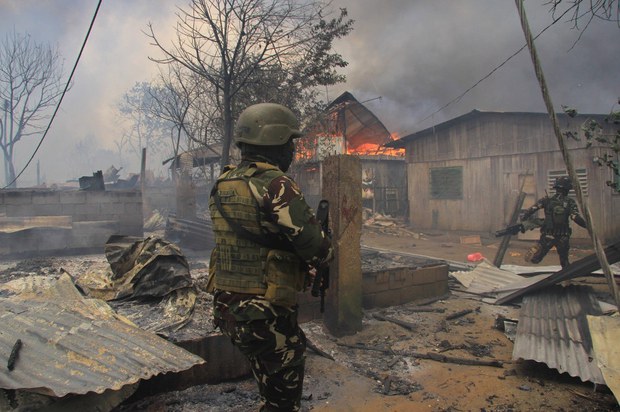Philippines: Marawi Death Toll Hits 547
2017.07.17
Marawi, Philippines
 Fire engulfs houses in the southern Philippine city of Marawi as government forces continue to battle Islamic State-linked militants, July 17, 2017.
Fire engulfs houses in the southern Philippine city of Marawi as government forces continue to battle Islamic State-linked militants, July 17, 2017.
The death toll in nearly eight weeks of fighting between Philippine forces and Islamic State-backed militants in the southern city of Marawi has reached 547 people, officials said Monday as the military pounded rebel-held positions with bombs, rockets and mortars.
Fifty-six days of fighting have left 97 troops and other security personnel dead, along with 45 civilians and 405 extremists, and another 852 servicemen wounded, Presidential spokesman Ernesto Abella told a news briefing in Manila as he gave a tally of updated casualty figures.
Troops have been engaging militants in gun battles to flush them out from an area in Marawi, almost two months after Abu Sayyaf Group (ASG) and Maute gunmen, backed by foreign fighters, took over large parts of the city in the heart of the predominantly Muslim southern Philippines.
In related developments on Monday, President Rodrigo Duterte vowed to shepherd through Congress a bill offering self-rule to the country’s Muslim minority. He said he was hopeful that the bill, also known as the Bangsamoro Basic Law, would convince Filipino Muslims to reject the extremist groups who seized Marawi.
The bill was jointly written and submitted to him Monday by government officials and the country’s largest Muslim guerrilla group, the Moro Islamic Liberation Front (MILF).
“This moment is a significant step forward in our quest to end centuries of hatred, mistrust and injustice that cost and affected the lives of millions of Filipinos,” Duterte said in a speech to MILF leaders and government officials.
Muslim secessionists had waged a decades-old insurgency that claimed more than 100,000 lives in the Mindanao region that includes Marawi. Duterte’s predecessor, Benigno Aquino III, signed a peace pact with the MILF in 2014 but Congress refused to pass the self-rule bill.
Duterte weighs extending martial law
On Monday, a fire razed a section of the ruined city where clashes were ongoing. It burned for about five hours before firefighters brought it under control.
Army Lt. Col. Jo-Ar Herrera, Joint Task Force Marawi spokesman, said troops were battling with 60 gunmen who were spread out in four villages along with their hostages.
“We are gaining more ground. The rebel-held area is getting smaller. We are committed and focused to finish the job as soon as possible,” Herrera said.
In Manila, overall military spokesman Col. Edgard Arevalo said the latest casualties included six gunmen and two soldiers who had died in firefights on Sunday.
He said 1,723 civilians had been rescued, although the gunmen were believed to be holding dozens of hostages, including a Catholic priest.
Fighting erupted on May 23 when troops and police moved in to arrest ASG leader Isnilon Hapilon, who is recognized as the leader of Islamic State (IS) in the Philippines. But the government forces were thwarted by superior firepower from the gunmen, who were backed by Southeast Asian and Middle Eastern fighters.
President Duterte, who was visiting Russia with his top security officials when the violence broke out, placed the entire southern island of Mindanao under martial law, giving the military extraordinary police powers to quell the violence. He also was forced to seek intelligence help from the United States, the nation’s longtime ally, and Australia.
The 60-day martial law declaration is to end on July 23, a day before Duterte’s state-of-the-nation address in Congress. There have been local reports that he plans to ask for an extension.
His spokesman, Abella, said the Department of National Defense had submitted its recommendation on the martial law as early as last Thursday, but Abella declined to divulge details.
“The president will go through and will make a decision on the matter,” Abella said.
“As we all know, the president listens and he considers the position not only of the military and of the police, but also the interests of vital stakeholders,” he said.
Last week, Duterte said the fighting was just days away ending, and that he was planning on visiting Marawi.
Attracting more foreign fighters
Meanwhile, an American analyst testified before a U.S. congressional subcommittee last week that the ongoing fighting in Marawi would eventually attract more foreign and local fighters.
Thomas Sanderson, the transnational threats project director at think-tank Center for Strategic and International Studies, told the House Committee on Foreign Affairs Subcommittee on Asia and the Pacific that without a short-term solution to the Marawi fighting, regional extremists might see Mindanao as a primary destination.
“None of that is good for the security of the Philippine nation, especially local civilians (Muslim, Christian, Buddhist and others) in desperate need of economic development and responsive government,” Sanderson said in his July 12 testimony.
An estimated 80 foreign fighters might have joined the Marawi battle and fighters from Saudi Arabia, Morocco, Chechnya, Yemen, Indonesia and Malaysia were among the fatalities, he said, quoting intelligence sources.







